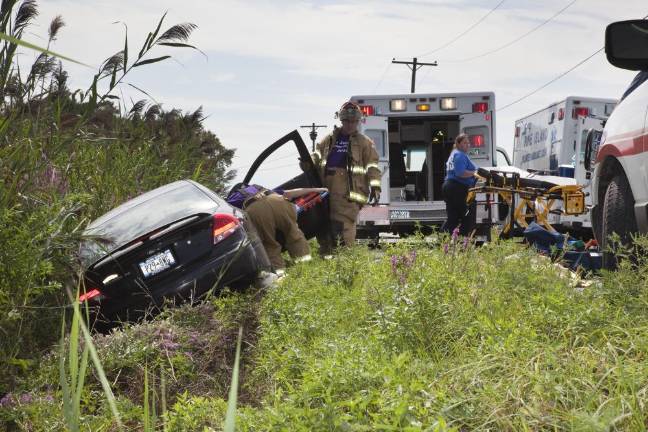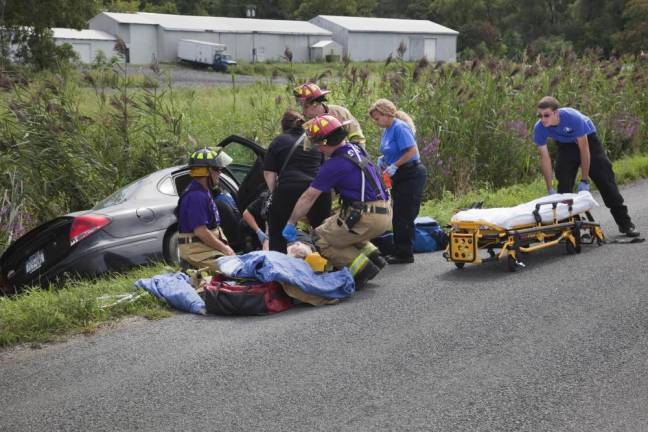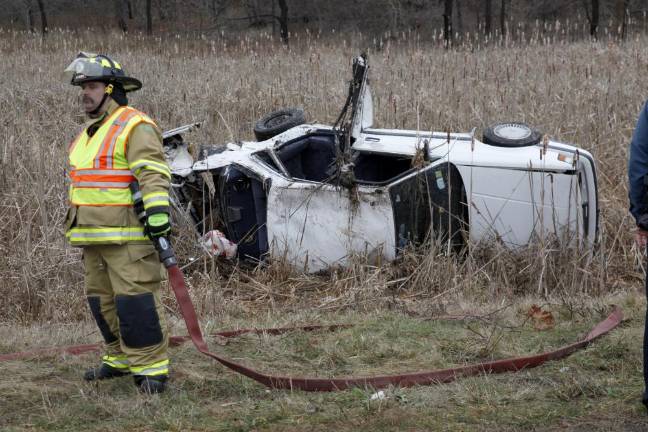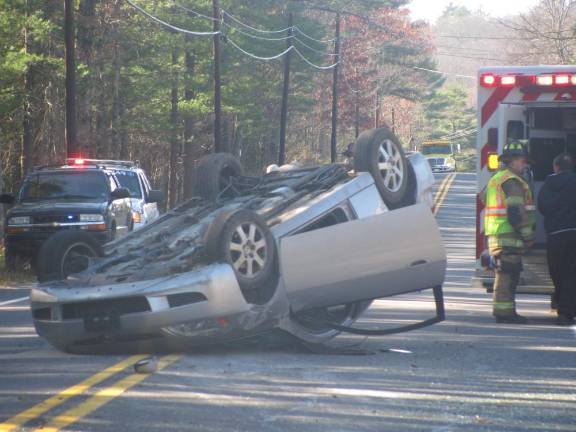The era of accelerated road rage
Highway hell. Record fatalities rack up as the reckless driving of the early pandemic gets even worse.




The Contreras family was headed home to Warwick, N.Y., on a Sunday evening in November after a relaxing weekend in Vermont when they came upon a cluster of three cars doing about 40 mph in a 55 mph zone, the last with its hazards on. Thinking little of it, Johnny Contreras moved into the left lane to pass the slow-moving group.
As their Toyota Highlander passed the front vehicle, a Dodge Ram “dually” pickup, it swerved into their lane, pushing them into the oncoming lane, which happened to be empty at that moment.
Too late, Contreras realized what the other cars had been attempting to signal: drunk driver.
“I was like, did that guy just try to push me off the road, or was he on his phone or something?” recalled Contreras, 36, who manages restaurants. So began what felt like a scene out of a horror movie, as the heavy-duty pickup – built for power with dual rear wheels on either side – gave chase to the smaller SUV. The couple’s two kids, four and six, were buckled into the back seat, with the dog in the way back.
“I got a few car lengths ahead of him, looked in the rearview mirror, noticed he was coming up on us really fast,” said Contreras.
What they didn’t know was that the truck’s driver, Todd Galiano, 39, the owner of a troubled construction company, had a previous DUI conviction and had been charged eight years earlier with using his Ram to run over a man he’d been in a fight with, breaking his leg. That aggravated assault offense, to which he pled guilty, resulted in a $294 fine, according to Vermont Superior Court records.
From the passenger seat, his partner, Shelley Garry, called 9-1-1 while Contreras stepped on the gas. Contreras hit 70 mph, and still the pickup was bearing down on them. As the family grew increasingly hysterical, Garry asked Contreras to let up on the gas. The pickup slammed into their tailgate, shattering the rear windshield all over the back of the car and the dog, which hopped over the seat to safety.
A couple hundred yards later, Contreras watched in his rearview as the pickup swerved and spun off the road into a clump of trees. He pulled over as the Highlander’s OnStar system automatically connected to 9-1-1.
When the police arrived, Galiano refused a breathalyzer and showed signs of intoxication, according to the police report. Medics checked the family out in an ambulance: Garry’s heartrate was so jacked they tested her three times before it came down enough that they would let her go.
“We were all, like, shaking,” said Contreras. “They also said, ‘I wish I could say this is the first time this has happened.’ But apparently it’s a thing that’s happening right now.”
The episode was as baffling as it was terrifying. Who tries to run a family off the road for legally passing? But it is part of a grim trend. After decades of safety gains, reckless driving has spiked since the pandemic, resulting in a 2020 death toll not seen since 2007 – a bizarre statistic, given the empty roads. And preliminary data show another 16 percent increase in traffic deaths as more people got back behind the wheel in the first half of 2021, according to the National Safety Council, a nonprofit safety advocate. It’s the largest six-month jump in traffic fatalities on record.
“I don’t know, we keep kind of chalking it up to a sign of the times,” said Contreras. “People are carrying this tremendous amount of baggage. When you’re in a car, I mean, it’s like a weapon, it’s a giant piece of metal. When alcohol and anxiety and stress, depression, all those things kind of coincide, what comes out of it can be really scary. I’ve definitely heard other stories and read other stories of road rage. I think we got off pretty easy, considering.”
Speed, alcohol, and massive vehicles
Vermont is going through a particularly rough patch, but it is far from alone. New York, New Jersey, and Pennsylvania – along with all but six states – saw still more traffic deaths in the first half of 2021 than in year one of the pandemic, when wide-open roads and the widespread realization that cops weren’t pulling people over much could at least partly explain the phenomenon.
“There are all kinds of indicators showing that risky driving is up,” said Shannon Frattaroli, a researcher at the Johns Hopkins Bloomberg School of Public Health. “People are driving faster, more likely to be driving under the influence of alcohol and drugs, and less likely to be wearing seatbelts. The fact that we are approaching our third year of pandemic life adds stress and strain, which is not conducive to safe driving.”
Add to that recipe our increasingly massive vehicles – which are safer for the people inside them, but more dangerous to everyone else. More than two out of three new automobiles now sold in the United States are “light trucks,” each year’s models setting new records for weight and horsepower. The result is a dangerous brew, with rural roads bearing the brunt of the carnage.
Nationwide, more of the fatal crashes in 2020 involved alcohol, younger drivers, people not wearing seatbelts and speeding than in years past, according to the U.S. Department of Transportation’s National Highway Safety Administration. Speeding by a lot.
New York State issued 17,001 tickets for extreme speeding in 2020, up from 10,311 the year before. That’s a 60 percent increase in drivers busted for going at least 31 mph over the speed limit – we’re talking 91 mph in a 60 mph zone – even as the total number of speeding tickets issued went down.
New Jersey saw an 18 percent year-over-year spike in traffic deaths in 2021, representing 106 more lives lost than the year before. Eleven of those people were killed on Sussex County roads, and 22 in Passaic County, according to state police data. That upsurge dwarfs the 5 percent increase in deadly car crashes that the state saw in 2020, along with a 7.5 percent increase in alcohol-related fatalities.
But Pennsylvania’s roads are by far the most dangerous in the tri-state region. They have gradually been getting less deadly, but the Keystone State still regularly records a death rate nearly twice as high as New York’s, according to Department of Transportation statistics. After speeding, the leading factor in fatal accidents nationwide, drunk driving was the second-leading cause of death in Pennsylvania in 2020. Alcohol accounted for an outsized percentage – over a quarter – of fatalities, though it was a factor in just 7 percent of crashes.
Lawmakers are trying to toughen laws for repeat drunk drivers in Pennsylvania. In November, the House of Representatives approved legislation to increase penalties for motorists with multiple DUI convictions to end what critics have called Pennsylvania’s “revolving door” for the most serious drunk drivers. The bill was inspired by Deana Eckman, a 45-year-old woman killed in 2019 by a five-time drunk driver who had been freed from prison a few months earlier.
The rise in traffic fatalities aligns with other deadly trends to emerge since the pandemic. Alcohol sales have soared, drug overdoses are at an all-time high, and homicides have spiked.
Anecdotes abound these days of drivers, usually men, becoming enraged at a minor infraction, perceived slight, or fender-bender, and reacting way out of proportion: blocking the offending car and getting out to menace the driver, tailgating, attempting to run them off the road, or even pulling out a gun.
About twice as many people were killed or wounded by gunshots in road rage incidents in 2020 as in the previous four years, according to a report by Everytown for Gun Safety, a national gun violence prevention organization. Nowadays, if a gun gets pulled, it’s far more likely to be used. From 2016 to 2019, roughly one-third of road rage altercations involving a gun resulted in injury or death. Between 2020 and 2021, half of them did.
What to do about it?
It’s a very American mentality to blame every bang-up on the actors involved. But other countries have taken a different approach: designing roads with an understanding that human error is not the exception, but the rule. “We need to be looking ahead to how to invest in a safe road infrastructure that will guard against these predictable human behaviors,” said Frattaroli, the Johns Hopkins researcher.
Take driving under the influence, the culprit for a major chunk of traffic deaths and injuries, independent of the pandemic. “Why do we make cars that people can drive while under the influence?” asked Frattaroli. The technology to prevent people from drinking and driving – ignition interlocks – has been around for years, and more advanced alcohol sensing technologies are in development. For professional drivers, she said, technologies that assure they are sober should be standard. In the case of Galiano, who had a previous DUI, and of Deanna Eckman’s killer, who had five: why were they able to start their car drunk?
Then there’s our physical infrastructure itself, made up of roads built to maximize capacity and encourage speed. “We know that how roads are designed can invite speed or cause drivers to slow down,” said Frattaroli. Other countries, like Sweden, are way ahead in designing for safety, she said, installing barriers and calming traffic in congested areas, and adding highway medians and roundabouts to slow traffic. In stark contrast to the U.S., the European Union saw a 17 percent reduction in the fatality rate on its roads between 2019 and 2020, according to the European Transport Safety Council.
With help from the federal infrastructure bill and the science at our fingertips, the time is ripe to make these kinds of longer-term investments, said Frattaroli.
Across the United States, some towns and cities have begun to respond to the reckless driving scourge, beefing up enforcement, dropping speed limits, and launching public education campaigns. In Stanhope, N.J., the borough council voted in November to spend $6,500 on a pair of portable radar speed signs, in response to concerns about speeding on residential streets.
“It seems like there was an uptick in speed [early pandemic] that hasn’t really abated,” said Stanhope Borough Administrator Brian McNeilly. “It particularly started to gravitate over to some of the side streets, connect-throughs and certainly our main street. Neighbors were just coming in complaining continuously.”
The speed monitoring signs can be moved from street to street, recording data like vehicle count, average speed, peak speed, and what time of day speeders tend to come through. That information allows the borough, with its small police force, to make informed decisions about when to station a squad car on a particular street, “so you get the best use of resources,” said McNeilly. The signs are still new, but so far seem to be working. “It does have a little bit of a habit changing effect,” said McNeilly. “You can see it in the data the following couple days.”
The borough also installed two larger permanent speed-monitoring signs as part of a nearly million-dollar street calming initiative that began in July 2020 on Sparta Road, where commuter traffic dumps out by the high school. In planning for five years, the project involves changing the look of the street, with treescapes, antique lighting and narrower lanes, along with restriping the road and adding activated crosswalk beacons. “Anything we can do to try to get the speed lowered, we’re for it,” said McNeilly, “particularly by the schools.”
New York City dropped speed limits by 5 mph on nine crash-prone roads and redesigned some streets to slow car traffic and give pedestrians and cyclists priority. Chicago’s speed cameras started ticketing drivers going at least six mph over the speed limit, down from the 10 mph threshold.
The response has been scattershot, though, with some states loosening their driving laws. In Maine, for instance, drivers convicted of criminal negligence that results in a driving-related death now have their license suspended for one year instead of three.
The mental toll
The damage to the Highlander, which was still in the shop six weeks after the ordeal, totaled about $10,000. The family has been doing physical therapy for minor whiplash, said Contreras, but for the most part they are physically okay. The toll is playing out in other, more subtle ways.
“The hardest is the mental aspect of it,” said Contreras. The what-ifs are haunting: What if the truck had hit them off-center at 70 mph, spinning them out? What if they hadn’t bought a new SUV five months earlier, a powerful all-wheel drive with a slew of safety features, like the ability to autocorrect and self-driving features to keep the car within the lines?
“It’s also a ginormous vehicle, you know?” he said. “Being in our little Rav 4, the scenario could have completely been changed, or if I was in my Prius, I mean God, who knows?”
Contreras has been driving more slowly since the attack, which may be a silver lining, he said. When a truck comes screaming up behind him now, he pulls off as soon as he can, even if that’s not actually the safest option. “I panic a little bit,” he said. “With somebody behind me I can’t focus on what’s in front of me because I’m just so worried.”
After their full names and hometown appeared in the police report, the family installed a new security system with cameras and extra sensors all over the house. “It is scary, knowing that someone who assaulted you with his car knows where you live,” said Contreras. Originally, they’d been ready to litigate to get Galiano off the road before something else happened, but eventually decided it was not worth the amplified fear factor. “I think we are just going to let it run its course and hope that the justice system serves its purpose,” said Contreras.
Galiano was recently arraigned on charges of DUI, gross negligent operation, and four counts of reckless endangerment, and is scheduled back in Bennington criminal court in February. But as the family was warned by a police officer: It’s very hard to convict people in Vermont.
“It’s still very fresh in my mind,” said Contreras. “It’s always there. If this (story) kind of helps people understand, and maybe have a little bit more sensitivity: some people have kids in the car. Your whole life is just, like, traveling down a highway at 60 miles per hour. If this can help one person think about what they’re doing, just take a deep breath before they wild out on the road, then I’m happy.”
“If this (story) helps people understand, and maybe have a little bit more sensitivity: some people have kids in the car. Your whole life is just, like, traveling down a highway at 60 miles per hour. If this can help one person think about what they’re doing, just take a deep breath before they wild out on the road, then I’m happy.” Johnny Contreras